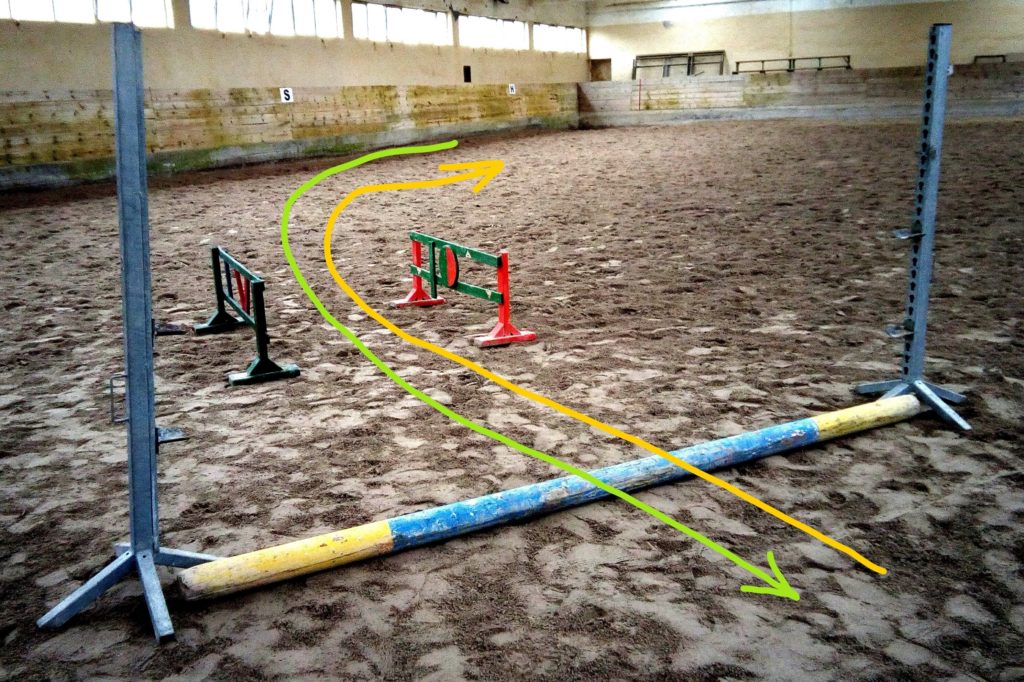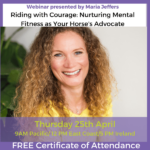USING PROPS TO IMPROVE MOVEMENT BY ALJA KISILAK
FUN IN THE ARENA
Do you ever wonder why it’s so difficult to ride a perfect serpentine or approach a fence effortlessly? It’s because finding your bearings in the arena can be very tricky. The arena is a big, open space, bigger than our field of vision. In addition to that we are sitting higher up than we are when we are walking around on our own two feet, which changes our perception of space. Moving at different speeds does that too. And then of course, imperfect communication between the horse and rider can be a big factor as well. All of this makes precise riding very difficult. We can make our lives easier by learning how to better navigate the big open space of the arena. This goes for both the rider and the horse. To help us learn and to make the process more fun, we can use props like letters, cones and ground poles.
USE LETTERS TO GET YOUR BEARINGS
Letters work wonders to help us navigate the arena and to aid the communication between the rider and the instructor. They act as coordinates for specific exercises in dressage tests and in effect they determine the rules of movement in the arena. An example of this is the diagonal. If the rider starts a diagonal at the letter K, he will usually finish it at the letter M. This makes his movement more predictable, which plays an important role in safety when there are more riders present in the arena. Using letters enables the rider to learn how to ride with more precision. A circle that begins at the letter B will be neater if we think of it in quarter pieces with support points at L, E and I.

(Above left) : The letters of the arena help us find our bearings. Children and beginners will easily remember them through an associative thumbnail (Above middle) : Cones help us get our bearings when we are away from the walls of the big, empty space of the riding arena. (Above right) : The riding elements, especially the poles, must be of high quality materials, well maintained and safe. The colors and shapes also play a big role.
CONES AS STEPPING STONES
When we move into the inside of the arena, we can’t rely only on the letters anymore. This is when cones come in and help us get our bearings when we are away from the arena walls. Cones help us improve our straight lines and turns, they can aid in better lateral flexion and help keep the horse focused. However, they are only a stepping stone. We use them when we are learning to execute an exercise precisely. After we’ve mastered the exercise with the cones, we remove them and try to get the same precision without them.
GETTING THE RIGHT PROPS: SOME TIPS
What material the props are made of and how they look is very important if we want them to be effective. A rule of thumb for the letters is that they should be big enough for an average rider to make out from the other end of the arena. The best combination are black letters on a white background. Instead of a cone we can use a similar looking object like a bucket or a big container. The important thing is that it’s made of a durable material (fabric, hard plastic, rubber or wood), of a color that stands out, is light and easy to move around, and safe in case the horse steps on it. The standard measure for ground poles is 3 m in length and a diameter of 10 cm. They can be shorter, depending on the goal of the training. If the horse is only starting to learn about poles, it is better that they are longer, whereas if our goal is to improve communication and accuracy, we can use poles as short as 1 m. The poles should be smooth and rounded to prevent any possible injuries if a horse should step on it. If we are using several poles in a row, we need to implement a prop that prevents the pole from rolling forward or backward it the horse hits it with his leg, as this could lead to the horse losing trust in the poles. The color is an important factor too. In the beginning phases its best to use a color that contrasts the footing. Avoid pastel colors unless the horse is skilled at working with ground poles. A good idea is to mark the middle of the pole to help riders guide their horses through the ground poles.
If you liked this post, you might be interested in the content linked to below:




